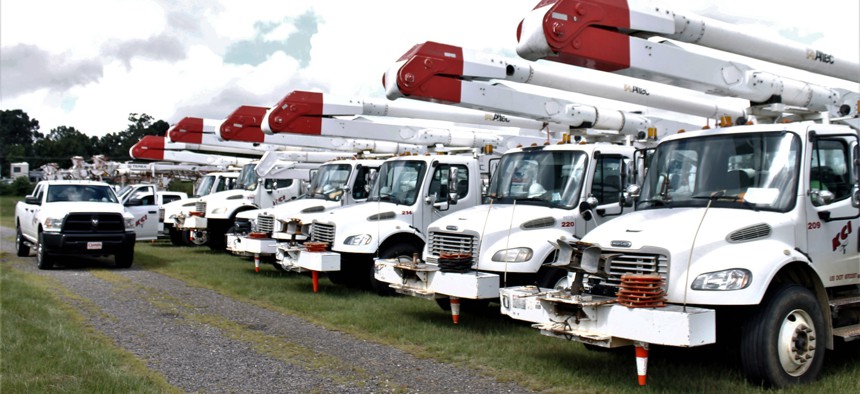Mutual Aid Agreements Bring First Responders, Utility Crews to Hurricane Zone

Utility trucks line up in a parking lot adjacent to Charlotte Motor Speedway in Concord, North Carolina, on Wednesday, Sept. 12, 2018. Skip Foreman / AP Photo

Connecting state and local government leaders
With conditions worsen in the Carolinas, rescue personnel and power crews are ready to respond when it's safe to do so.
As Hurricane Florence began battering the Carolinas on Thursday, first responders and utility crews from around the region and beyond have been mobilizing to assist communities and local agencies that will be dealing with the aftermath of the massive storm.
Near Nashville, Tennessee, the Wilson County Emergency Management Agency tweeted out a video montage on Thursday showing its emergency medical services strike team heading to Kinston, North Carolina ahead of the storm.
In northeastern Tennessee, the Region 1 Ambulance Strike Team, which consists of emergency response organizations in an eight-county region sent their “AMBUS”—which the Times News described as “a bus converted to an ambulance for multi-patient transport”—to Myrtle Beach, South Carolina on Monday, where it assisted the evacuation of patients from medical facilities.
Those crews from Tennessee are just some of many that have taken up position in the Carolinas ahead of Florence’s arrival.
Earlier this week, a team of 18 first responders from the South Bend, Mishawaka, Elkhart and Clay and Warsaw township fire departments left northern Indiana and took position in Havelock, North Carolina, according to the South Bend Tribune. They’re part of the MABAS Division 201 Technical Rescue Team, an 86-member unit with water-rescue training.
Havelock is located along the Nuese River near New Bern, which started overflowing its banks on Thursday as a 10-foot storm surge flooded parts of low-lying New Bern and the surrounding area.
In Alabama, a six-person power restoration team from Opelika Power Services left for Greensboro, North Carolina on Wednesday. “We are grateful to Mayor [Gary] Fuller and the Opelika City Council for allowing us the ability to provide the training, tools, and equipment to not only do our jobs safely and efficiently here in Opelika, but the ability to help other communities when needed,” said OPS director Derek Lee, according to The Opelika-Auburn News.
Power restoration won’t begin until the storm has passed and given Florence’s forecast, that effort may not get fully underway for few days when conditions improve. Duke Energy, which provides electricity to parts of North and South Carolina, is estimating that 1 million to 3 million of its customers will lose power, The Post & Courier reported.
About 500 Florida Power & Light personnel moved into position in South Carolina ahead of Florence’s arrival. “This is what we do. When severe weather strikes, the nation’s electric companies work together to get the lights back on,” Eric Silagy, FPL’s president and CEO, told Florida Today.
Michael Grass is Executive Editor of Government Executive’s Route Fifty and is based in Seattle.

NEXT STORY: Chaos in 3 Massachusetts Cities After Dozens of Gas Explosions





